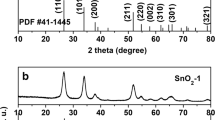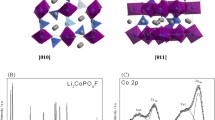Abstract
TiO2 is a potential anode for lithium-ion batteries. The low theoretical capacity and inferior reaction kinetics limit its wide applications. In this work, the H2Ti3O7 nanorods were prepared by hydrothermal reaction and washed with HCl, deionized water, and ethanol. The TiO2 nanorods possessing the mesoporous structure with several nanometers were obtained by annealing H2Ti3O7 at different temperatures (300 °C, 400 °C, and 500 °C) under Ar atmosphere. The carved mesoporous structure can form channels for the transport of electrolyte ions into the interior. So the prepared TiO2 exhibited superior rate performance compared to general TiO2. As expected, the first discharge and charge capacity of TiO2-400 were 248 and 192 mA h g−1, and the corresponding Coulombic efficiency for the first cycle was 77%. Furthermore, the high rate performance paved the way for future research on Li-ion batteries based on TiO2.




Similar content being viewed by others
Data availability
The datasets and the materials used or analyzed during the current study are available from the corresponding author on reasonable request.
References
Goodenough JB, Kim Y (2010) Challenges for rechargeable Li batteries. Chem Mater 22:587–603
Xu J, Zhang J, Pollard TP, Li Q, Tan S, Hou S, Wan H, Chen F, He H, Hu E, Xu K, Yang XQ, Borodin O, Wang C (2023) Electrolyte design for Li-ion batteries under extreme operating conditions. Nature 614:694–700
Xu J, Pollard TP, Yang C, Dandu NK, Tan S, Zhou J, Wang J, He X, Zhang X, Li A-M, Hu E, Yang X-Q, Ngo A, Borodin O, Wang C (2023) Lithium halide cathodes for Li metal batteries. Joule 7:83–94
Wang S, Li X, Cheng T, Liu Y, Li Q, Bai M, Liu X, Geng H, Lai W-Y, Huang W (2022) Highly conjugated three-dimensional covalent organic frameworks with enhanced Li-ion conductivity as solid-state electrolytes for high-performance lithium metal batteries. J Mater Chem A 10:8761–8771
Wang Q, Wang S, Lu T, Guan L, Hou L, Du H, Wei H, Liu X, Wei Y, Zhou H (2022) Ultrathin solid polymer electrolyte design for high-performance Li metal batteries: a perspective of synthetic chemistry. Adv Sci 10:2205233
Wang S, Bai M, Liu C, Li G, Lu X, Cai H, Liu C, Lai W-Y (2022) Highly stretchable multifunctional polymer ionic conductor with high conductivity based on organic-inorganic dual networks. Chem Eng J 440:135824
Liu Y, Zeng Q, Li Z, Chen A, Guan J, Wang H, Wang S, Zhang L (2023) Recent development in topological polymer electrolytes for rechargeable lithium batteries. Adv Sci 2206978
Zhang L, Gao H, Xiao S, Li J, Ma T, Wang Q, Liu W, Wang S (2022) In-situ construction of ceramic-polymer all-solid-state electrolytes for high-performance room-temperature lithium metal batteries. ACS Mater Lett 4:1297–1305
Wang S, Cheng T, Zhang YZ, Wu X, Xiao S, Lai W-Y (2022) Deformable lithium-ion batteries for wearable and implantable electronics. Appl Phys Rev 9:041310
Zhang L, Gao H, Guan L, Li Y, Wang Q (2023) Polyzwitterion-SiO2 double-network polymer electrolyte with high strength and high ionic conductivity. Polymers 15:466
Winter M, Barnett B, Xu K (2018) Before Li ion batteries. Chem Rev 118:11433–11456
Xu K (2004) Nonaqueous liquid electrolytes for lithium-based rechargeable batteries. Chem Rev 104:4303–4418
Li J, Liu L, Wang J, Zhuang Y, Wang B, Zheng S (2023) Freestanding TiO2 nanoparticle-embedded high directional carbon composite host for high-loading low-temperature lithium-sulfur batteries. ACS Sustain Chem Eng 11:3657–3663
Zhang M, Lu A, Li H, LiM WJ, Wang C (2023) Defective TiO2-supported dual-Schottky heterostructure boosts fast reaction kinetics for high performance lithium-ion storage. ACS Appl Energy Mater 6:1781–1798
Lee KJ, Bak W, Kim J-J, Snyder MA, Yoo WC, Sung Y-E (2015) How pore parameters affect Li ion depletion in mesoporous materials for lithium-ion batteries. J Phys Chem C 119:7604–7613
Saravanan K, Ananthanarayanan K, Balaya PE (2010) Mesoporous TiO2 with high packing density for superior lithium storage. Environ Sci 3:939–948
Chen X, Mao SS (2007) Titanium dioxide nanomaterials: synthesis, properties, modifications, and applications. Chem Rev 107:2891–2959
Chen D, Caruso RA (2013) Recent progress in the synthesis of spherical titania nanostructures and their applications. Adv Funct Mater 23:1356–1374
Koudriachova MV, Harrison NM, de Leeuw SW (2001) Effect of diffusion on lithium intercalation in titanium dioxide. Phys Rev Lett 86:1275
Lunell S, Stashans A, Ojamae L, Lindstrom H, Hagfeldt A (1997) Li and Na diffusion in TiO2 from quantum chemical theory versus electrochemical experiment. J Am Chem Soc 119:7374–7380
Xu J, Ding W, Yin G, Tian Z, Zhang S, Hong Z, Huang F (2018) Capacitive lithium storage of lithiated mesoporous titania. Materials Today Energy 9:240–246
Shi H, Shi C, Jia Z, Li A, HeB LT, Chen J (2023) Flower-like TiO2 and TiO2@C composites prepared via a one-pot solvothermal method as anode materials for lithium-ion batteries: higher capacity and excellent cycling stability. Dalton Transactions 52:4214–4223
Mishra S, Yogi P, Sagdeo PR, Kumar R (2018) TiO2-Co3O4 core-shell nanorods: bifunctional role in better energy storage and electrochromism. ACS Appl Energ Mater 1:790–798
Etacheri V, Yourey JE, Bartlett BM (2014) Chemically bonded TiO2-bronze nanosheet/reduced graphene oxide hybrid for high-power lithium ion batteries. ACS Nano 8:1491–1499
Yarali M, Biçer E, Gürsel SA, Yürüm A (2016) Expansion of titanate nanotubes by the use of a surfactant and its improved performance as an anode in Li-ion batteries. Electrochimica Acta 220:453–464
Li S, Song Y, Wan Y, Zhang J, Liu X (2023) Hierarchical TiO2 nanoflowers percolated with carbon nanotubes for long-life lithium storage. J Electroanal Chem 934:117305
Luo B, Wang W, Wang Q, Ji W, Yu G, Liu Z, Zhao Z, Wang X, Wang S, Zhang J (2023) Facilitating ionic conductivity and interfacial stability via oxygen vacancies-enriched TiO2 microrods for composite polymer electrolytes. Chem Eng J 460:141329
Shen S, Jiang X, Zheng Y, Xue X-X, Feng Y, Zeng J, Chen K-Q (2023) Fast carrier diffusion via synergistic effects between lithium-ions and polarons in rutile TiO2. Phys Chem Chem Phys 25:7519–7526
Takami N, Harada Y, Iwasaki T, Hoshina K, YoshidaY (2015) Micro-size spherical TiO2(B) secondary particles as anode materials for high-power and long-life lithium-ion batteries. J Power Sources 273:923–930
Duan J, Hou H, Liu X, Yan C, Liu S, Meng R, Hao Z, Yao Y, Liao Q (2016) In situ Ti3+-doped TiO2 nanotubes anode for lithium ion battery. J Porous Mat 23:837–843
Han H, Song T, Lee E-K, Devadoss A, Jeon Y, Ha J, Chung Y-C, Choi Y-M, Jung Y-G, Paik U (2012) Dominant factors governing the rate capability of a TiO2 nanotube anode for high power lithium ion batteries. ACS Nano 6:8308–8315
Sudant G, Baudrin E, Larcher D, Tarascon JM (2005) Electrochemical lithium reactivity with nanotextured anatase-type TiO2. J Mater Chem 15:1263–1269
Liang S, Wang X, Qi R, Cheng Y-J, Xia Y, Mueller-Buschbaum P, Hu X (2022) Bronze-phase TiO2 as anode materials in lithium and sodium-ion batteries. Adv Funct Mater 32:2201675
Pan JH, Zhang X, Du AJ, Sun DD, Leckie JO (2008) Self-etching reconstruction of hierarchically mesoporous F-TiO2 hollow microspherical photocatalyst for concurrent membrane water purifications. J Am Chem Soc 130:11256–11257
Wang Z, Lou XW (2012) TiO2 nanocages: fast synthesis, interior functionalization and improved lithium storage properties. Adv Mater 24:4124–4129
Yin H, Lin TQ, Yang CY, Wang Z, Zhu GL, Xu T, Xie XM, Huang FQ, Jiang MH (2013) Gray TiO2 nanowires synthesized by aluminum-mediated reduction and their excellent photocatalytic activity for water cleaning. Chem-Eur J 19:13313–13316
Wang DH, Choi D, Yang ZG, Viswanathan VV, Nie Z, Wang CM, Song YJ, Zhang JG, Liu J (2008) Synthesis and Li-ion insertion properties of highly crystalline mesoporous rutile TiO2. Chem Mater 20:3435–3442
Armstrong G, Armstrong AR, Bruce PG, Reale P, Scrosati B (2006) TiO2(B) nanowires as an improved anode material for lithium-ion batteries containing LiFePO4 or LiNi0.5Mn1.5O4 cathodes and a polymer electrolyte. Adv Mater 18:2597
Li JR, Tang ZL, Zhang ZT (2005) Layered hydrogen titanate nanowires with novel lithium intercalation properties. Chem Mater 17:5848–5855
Park MS, Ma SB, Lee DJ, Im D, Doo SG, Yamamoto O (2014) A highly reversible lithium metal anode. Sci Rep 4:3815
Li Y, Huang Y, Zheng Y, Huang R, Yao J (2019) Facile and efficient synthesis of Α-Fe2o3 nanocrystals by glucose-assisted thermal decomposition method and its application in lithium ion batteries. J Power Sources 416:62–71
Zheng Y, Li Y, Yao J, Huang Y, Xiao S (2018) Facile synthesis of porous tubular nio with considerable pseudocapacitance as high capacity and long life anode for lithium-ion batteries. Ceram Int 44:2568–2577
Kim H-S, Cook JB, Lin H, Ko JS, Tolbert SH, Ozolins V, Dunn B (2017) Oxygen vacancies enhance pseudocapacitive charge storage properties of MoO3-x. Nat Mater 16:454–460
Funding
This work was financially supported by the National Natural Science Foundation of China (Grant No. 22109017), the General Natural Science Research Projects of Colleges and Universities in Anhui Province (Grant No. KJ2021B14), the Anhui Provincial Science and Technology Key R&D Program (Grant No. 2022a05020055), and the Key Research and Development Program of Anhui Province (Grant No. 202104b11020010).
Author information
Ethics declarations
Ethical approval
This declaration is “not applicable.”
Conflict of interest
The authors declare no competing interests.
Additional information
Publisher’s Note
Springer Nature remains neutral with regard to jurisdictional claims in published maps and institutional affiliations.
Supplementary information
ESM 1
Figure S1 (a) BET adsorption and desorption isotherm curves for TiO2-400. (b) BJH pore size distribution for TiO2-400. Figure S2 Nyquist plots of Li-TiO2-400 and anatase nanoparticles. Inset: Randles equivalent circuit for all tested electrodes. Figure S3 TEM images of TiO2-400 after 400 cycles at 0.2C
Rights and permissions
Springer Nature or its licensor (e.g. a society or other partner) holds exclusive rights to this article under a publishing agreement with the author(s) or other rightsholder(s); author self-archiving of the accepted manuscript version of this article is solely governed by the terms of such publishing agreement and applicable law.
About this article
Cite this article
Wang, X., Jin, G., Zhang, L. et al. Capacitive lithium storage of carved mesoporous titania. Ionics 29, 4907–4912 (2023). https://doi.org/10.1007/s11581-023-05179-5
Received:
Revised:
Accepted:
Published:
Issue Date:
DOI: https://doi.org/10.1007/s11581-023-05179-5




